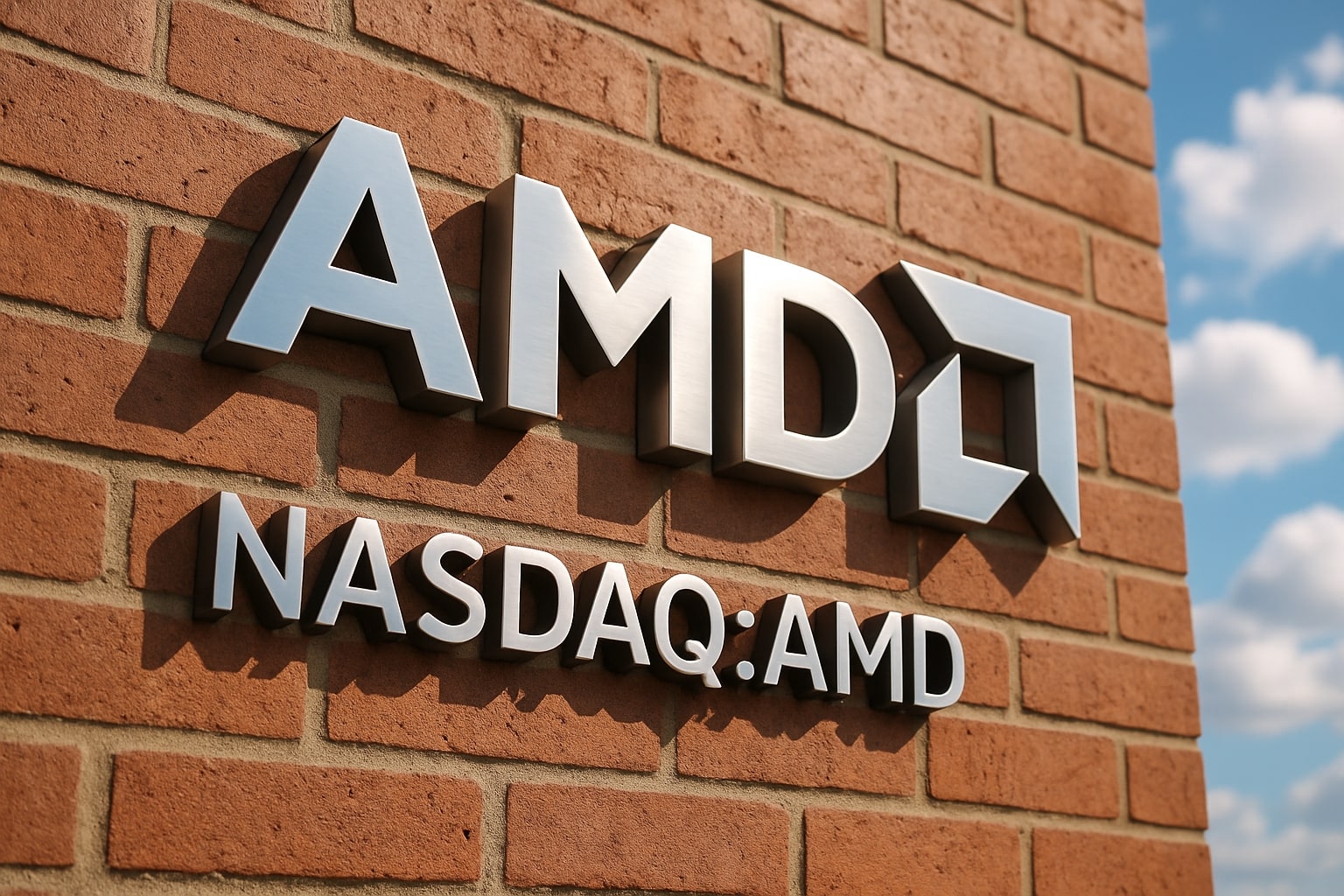
AMD Stock Price Forecast - AMD Price Holds $159 After Q2 Beat and Strong AI Partnerships
AMD delivers 27% revenue growth outlook, expands in AI and quantum, while analysts split on near-term demand | That's TradingNEWS
Advanced Micro Devices (NASDAQ:AMD) Stock Analysis: Growth Momentum, AI Uncertainty, and Valuation
Earnings Performance and Market Reaction for NASDAQ:AMD
Advanced Micro Devices (NASDAQ:AMD) is trading near $159.40 after sliding 0.94% in the last session, despite beating Q2 revenue expectations. The company posted $7.7 billion in quarterly sales, above the $7.42 billion consensus, while adjusted EPS came in at $0.48, matching estimates but marking a 30% year-over-year decline. Investors initially pushed the stock higher, but the shares reversed lower as traders looked for stronger upside after a three-month rally of nearly 50%. Gross margin guidance for Q3 was set at 54%, in line with last year, while revenue guidance stood at $8.7 billion at the midpoint, representing 27.6% year-over-year growth.
Data Center and AI Accelerator Outlook for NASDAQ:AMD
AMD’s data center business delivered $3.2 billion in revenue, up 14% year-over-year, a slowdown from the prior quarter’s 57% surge. Growth came from EPYC CPU adoption across hyperscalers, but concerns remain about the pace of GPU traction in AI accelerators. The Instinct MI350 launch was touted as a high-bandwidth alternative, with Oracle deploying 5th Gen EPYC Turin CPUs and MI355X accelerators in its AI clusters. However, Seaport Research Partners downgraded AMD to Neutral, warning that many evaluation orders may not scale into volume deployments. By contrast, Truist Securities reiterated a Buy with a $213 price target, highlighting growing hyperscaler partnerships. This divergence underscores uncertainty over whether AMD can convert early AI customer wins into sustained market share gains against Nvidia (NASDAQ:NVDA), which still dominates training workloads.
Client, Gaming, and Embedded Segments Drive Mixed Results
The client and gaming segment surged 69% year-over-year to $3.6 billion, fueled by record demand for Ryzen CPUs, Radeon GPUs, and console processors. This sharp rebound follows more moderate 28% growth in Q1 and highlights strong consumer adoption. The embedded segment, however, declined 4% to $824 million, reflecting mixed demand in industrial and edge markets. While small relative to AMD’s core businesses, this segment remains an important piece of diversification as AI expands into embedded and IoT devices.
Institutional Ownership and Insider Developments for NASDAQ:AMD
Active fund manager exposure to AMD has dropped significantly. Bank of America data shows ownership fell to just 20% in August, down from 39% a year ago, making AMD the least-held semiconductor stock in the S&P 500 despite its 34% year-to-date gain. The shift reflects cautious institutional positioning even as analysts project 22% sales growth for fiscal 2025. On the corporate side, Chief Accounting Officer Philip Carter announced his resignation effective September 5, transitioning to a CFO role elsewhere. Insider activity can be tracked in detail on the AMD insider transaction page, where filings show executives actively adjusting positions against the backdrop of heightened volatility.
Strategic Partnerships and AI Expansion for NASDAQ:AMD
AMD has been aggressively pushing into artificial intelligence. The June announcement of new AI chips secured commitments from Meta Platforms (NASDAQ:META) and Oracle (NYSE:ORCL) Cloud, signaling meaningful traction. The company also unveiled a strategic partnership with IBM (NYSE:IBM) to develop quantum-centric supercomputing, combining AMD CPUs, GPUs, and FPGAs with IBM’s quantum systems. While these alliances highlight long-term growth opportunities, near-term execution challenges remain, especially around securing export licenses for China. Recently, U.S. regulators approved shipments of the Instinct MI308, a development expected to lift data center revenue in coming quarters.
Financial Position and Valuation Metrics for NASDAQ:AMD
AMD’s balance sheet remains strong with a current ratio of 2.49, supporting liquidity as the company scales in AI. Revenue for fiscal 2025 is projected at $43.6 billion, with EPS estimates of $11.89, up from $10.22 in 2024. Analysts forecast EPS growth of 16.4% for 2025, slowing to 1.6% in 2026 as expenses catch up. Shares trade at a forward P/E of 41.3, well above the five-year average, reflecting premium pricing for AI exposure. By comparison, Nvidia trades at even higher multiples, while Intel (NASDAQ:INTC) trades at a discount as it struggles with execution. AMD’s valuation looks stretched, but many analysts argue it is justified given its strategic positioning.
Read More
-
AbbVie Stock Price Forecast - ABBV at $229 Turns the Humira Cliff Into a 2026 Growth Engine
02.01.2026 · TradingNEWS ArchiveStocks
-
XRP Price Forecast - XRP-USD Nears $2 as $1.80 Support and Shrinking Supply Point to $2.60 Target
02.01.2026 · TradingNEWS ArchiveCrypto
-
Oil Price Forecast - Oil Slide Into 2026: WTI Stuck at $57, Brent at $60
02.01.2026 · TradingNEWS ArchiveCommodities
-
Stock Market Today: Nasdaq Hits 23,467 as Nvidia (NVDA), Micron (MU) and Baidu (BIDU) Drive AI Surge
02.01.2026 · TradingNEWS ArchiveMarkets
-
GBP/USD Price Forecast: Pound Holds 1.3450 as Fed–BoE Split Keeps Bulls Aiming at 1.37
02.01.2026 · TradingNEWS ArchiveForex
Market Sentiment and Analyst Ratings on NASDAQ:AMD
Opinions remain divided. Truist Securities reaffirmed a Buy with a $213 target, citing growing datacenter partnerships. Mizuho raised its target to $205 with an Outperform rating, forecasting $8.8 billion in September quarter revenue. Seaport Global, however, downgraded to Neutral, warning that near-term AI demand may not meet elevated expectations. Bank of America maintained a Buy rating, calling AMD a key beneficiary of Intel’s market share erosion. The average analyst target across Wall Street stands near $190, reflecting both bullish and cautious perspectives.
Risks and Growth Catalysts for NASDAQ:AMD
Key risks include slowing hyperscaler capex, with Microsoft (NASDAQ:MSFT) signaling reduced 2026 investment while Meta pledged to “ramp investments significantly.” Export restrictions remain a wild card, with China sales dependent on government approvals. Competitive pressure from Nvidia in AI and Arm Holdings (NASDAQ:ARM) in low-power computing is intense, while geopolitical risks around tariffs and supply chains remain elevated. On the positive side, AMD’s $8.7 billion revenue guidance, new Instinct product approvals, and IBM partnership all point toward sustained growth momentum.
Final Take on NASDAQ:AMD
Advanced Micro Devices remains one of the most volatile yet strategically important semiconductor names. With shares at $159, guidance calling for double-digit revenue growth, and analysts projecting upside toward $190–$213, the stock still offers growth appeal despite stretched valuation. Institutional investors have trimmed exposure, but the company’s long-term AI, data center, and gaming opportunities remain compelling. Against peers, AMD looks fairly valued rather than cheap, but the combination of execution strength, new product rollouts, and diversification into AI computing makes the case for a Buy stance on NASDAQ:AMD at current levels.


















